Published: July 2025.
Below are 10 key health challenges for Wakefield district in 2025. For more detailed factsheets, please see the JSNA Annual Reports.
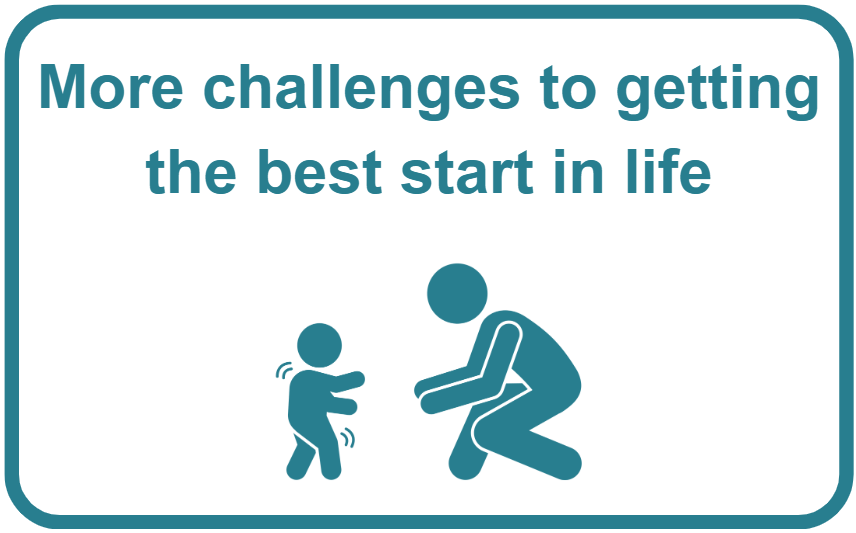
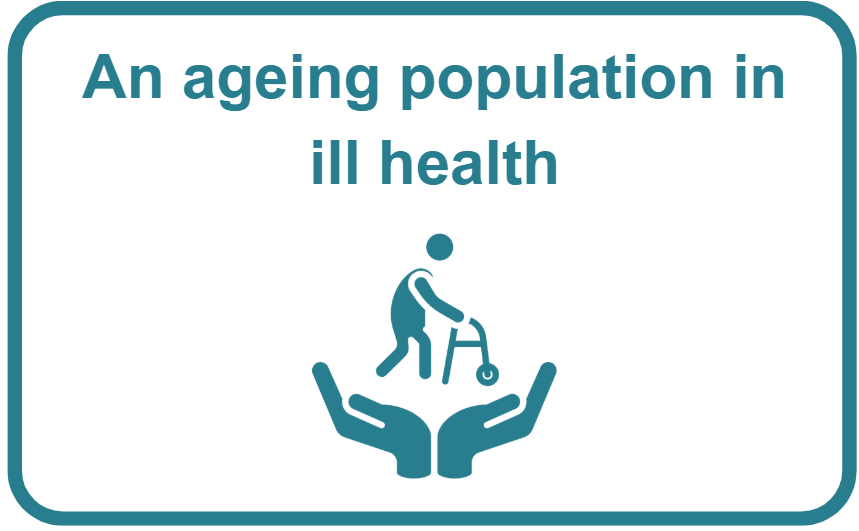
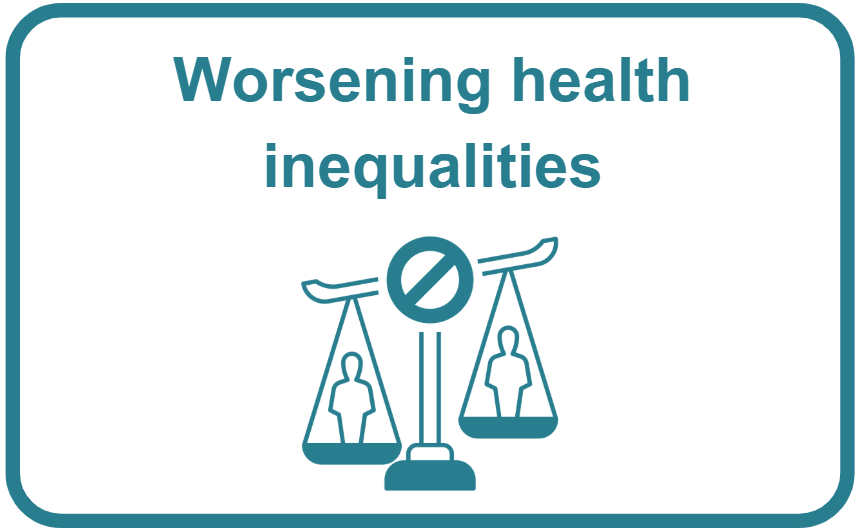

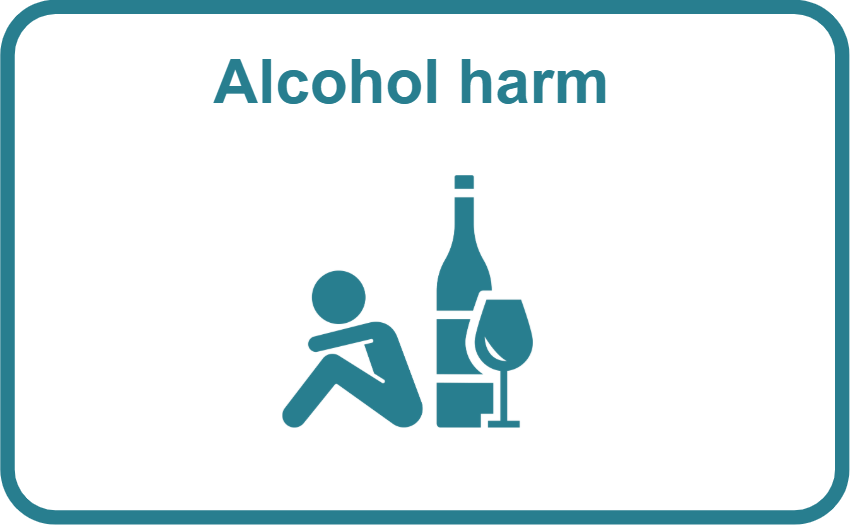

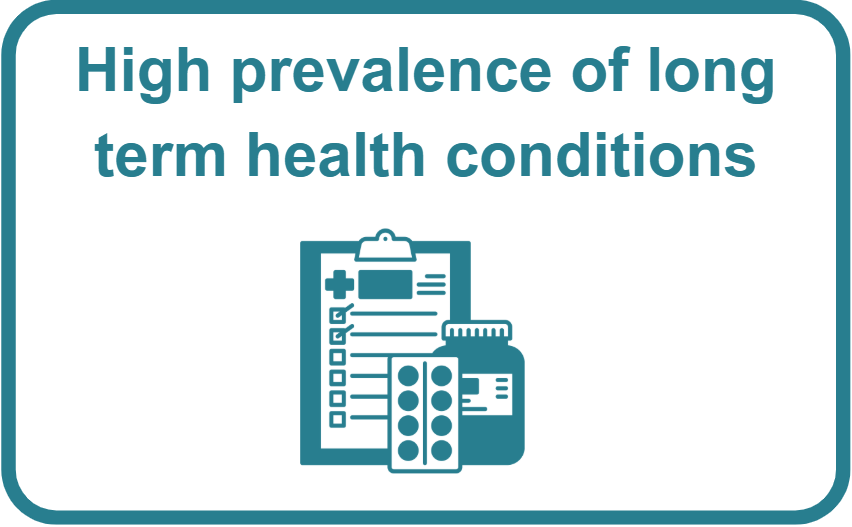
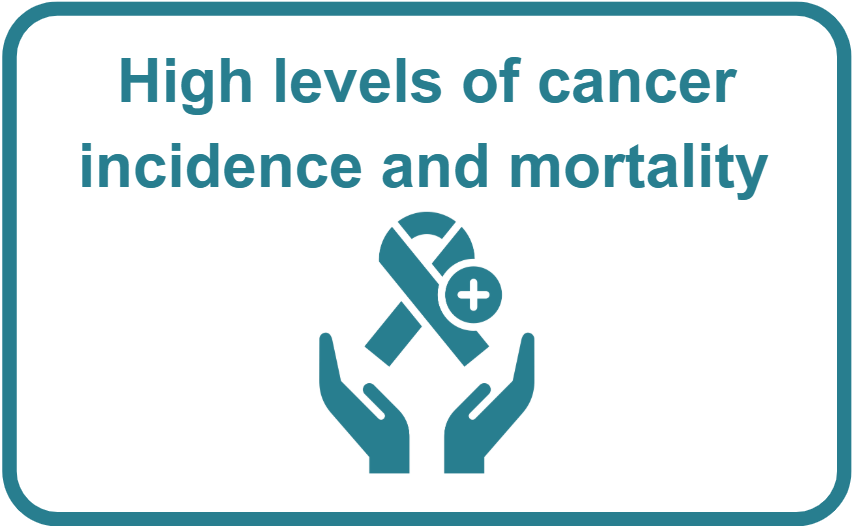
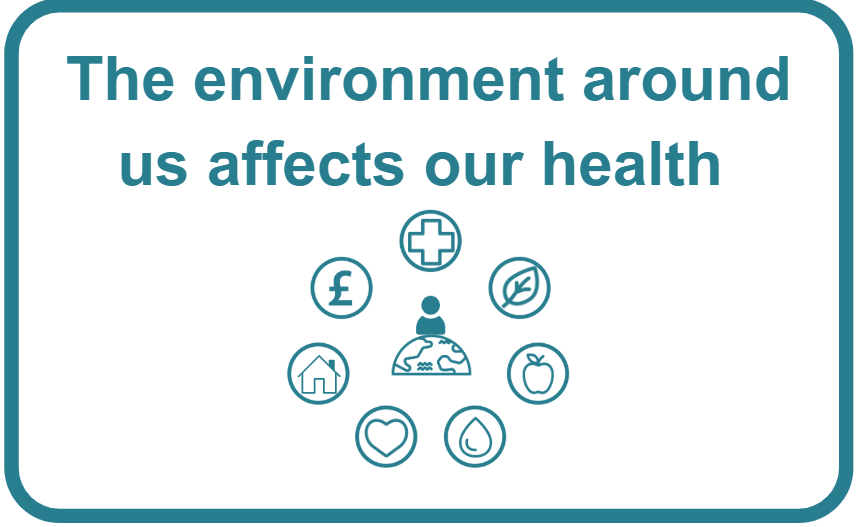
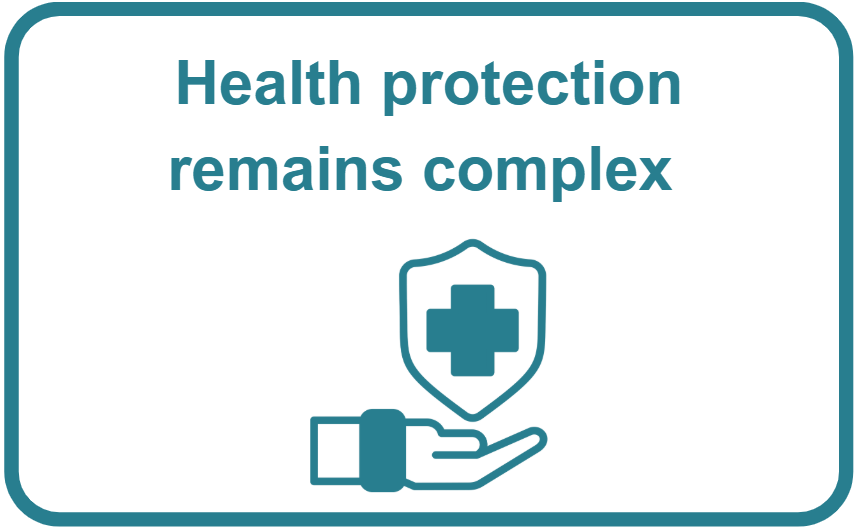
The 10 key health challenges:
 |
Current data suggests a child born in Wakefield District can expect to live on average 78 years (males) or 81 years (females) (2021-23). Life expectancy at birth for Wakefield has been lower than the England average for over a decade and the gap has not reduced [1]. Breastfeeding rates are significantly lower than national levels [2]. Older children are affected by increasing school absence rates. In 2023-24, around 1 in 5 primary and secondary pupils in Wakefield missed 10% or more of their schooling during the year [3].
There are a variety of services supporting children and their families across Wakefield working to achieve better outcomes for children and young people including a new children and young people’s plan. The district sees a significantly higher percentage of children at a good level of development at their 2-2.5 year old check, at 89% across Wakefield compared to 80% nationally [4].
|
 |
Population estimates predict that in the next 10 years the population aged 75+ in Wakefield will increase by 19%, from around 34,500 to almost 41,000. However, a good quality of life is being cut short for many. The number of years a person can expect to live a healthy life, free from illness or disability has been falling [5]. Healthy life expectancy for males and females is currently 56 years. This means that a high number of people can expect to live most of their older years in poor health – around 22 years for men and 25 years for women. As more of the population live to 80 years and beyond, they will be at higher risk of developing multiple health conditions including dementia and age-related frailty. This will lead to an increased need to provide support to family and friends taking on unpaid carer roles and a requirement for local health and social care systems to be able to respond to these changing needs.
Across Wakefield older people are supported to age well by maintaining independence, managing long term conditions, participating in social and cultural events and keeping active. Support is provided to those caring for people who are older and residential care home places are available if needed for eligible local residents.
|
 |
There is a strong link between health and wealth, with many people in the poorer parts of the district experiencing worse health outcomes. People from deprived backgrounds experience disproportionate health harms in a range of ways including increased likelihood of smoking, having excess weight, having long-term health conditions, and subsequently dying younger. Men in the most deprived areas of Wakefield District can expect to live around 9 years fewer than those in the most affluent areas, for women this is 8 years [6]. There are groups of people in Wakefield such as unpaid carers, the LGBTQ+ community, neurodivergent people or those who were born outside the UK for whom services are not always easy to access and have poorer health outcomes.
Health needs assessments are used in Wakefield to help discover the types of barriers people face, to ensure resources are focused on making services more accessible to everyone and to find ways to improve outcomes.
|
 |
The proportion of the adult population who are living with overweight (including obesity) is currently 70% [7]. Too many children are living with excess weight and the numbers increase from reception year to year 6, with around 25% of reception children and 37% of Year 6 children living with excess weight in the 2023/24 school year [8]. Obesity in early pregnancy is also an issue and on the rise at nearly one third of pregnant women across Wakefield [9]. Obesity is a major risk factor for Type 2 diabetes, hypertension, cardiovascular disease, and certain cancers, it also negatively impacts on mental health and overall wellbeing [10].
Tackling rising obesity levels is not simply an issue of people changing what they eat and how much exercise they do but influenced by a range of interconnected wider factors [11]. As a result of this complexity there is a need for increased whole-system action [12] to address the conditions that contribute to the obesogenic environment. Wakefield District offers a range of support services, including healthy eating and physical activity programmes for individuals and families and specialist weight management services. Key actions include planning policy, addressing the commercial determinants of health and supporting the Wakefield District Good Food Partnership.
|
 |
There are more than 1,100 premises in the district licenced to sell alcohol (July 2025). Drinking alcohol is associated with risks of developing noncommunicable diseases such as liver diseases, heart diseases, and different types of cancers, as well as mental health and behavioural conditions such as depression, anxiety and alcohol use disorders [13] [14]. Wakefield residents with alcohol dependence were more likely to have a diagnosis of depression. Over a third of adults who regularly consume alcohol in Wakefield drink over the recommended 14 units of alcohol a week. Alcohol is a major contributor to deaths and illness in younger people (15-49 year olds) in the district, being the second most common risk factor for mortality after drug use.
Prevention, advice and treatment services in the district provide extensive support which is accessible to people experiencing alcohol harm including both those directly affected, their families and the wider community across a range of community, healthcare and residential settings. Trends from the Wakefield School Health Survey show a higher percentage of pupils have never tried alcohol than in previous surveys [15].
|
 |
Mental ill health is affecting a large number of people in Wakefield, trends have shown increasing numbers of people diagnosed with anxiety and depression. Rates of low mental wellbeing (7% of Y9 pupils) and loneliness in children (52% of Y9 pupils) increased during the pandemic and though they have since fallen they are not yet back to pre-pandemic levels. The suicide rate in Wakefield is one of the highest in the country. For information on suicide prevention and support, visit: West Yorkshire Suicide Prevention.
There is a spectrum of mental health support available across Wakefield from local initiatives to support individual wellbeing, to community based talking therapies and clinical services. For information on mental health support services in Wakefield, visit: Adult mental health support – Wakefield Council. The 2024 Wakefield District School Health Survey findings suggest an improving picture for some aspects of children and young people’s mental health compared to 2020 levels. There is evidence of an increase in happiness and a decrease in loneliness.
|
 |
Almost 50% of all residents have one or more long term conditions. High prevalence of risk factors such as smoking, obesity and alcohol consumption means that Wakefield has higher rates than the national average of many long term conditions including cardiovascular disease [16] and respiratory conditions [17], which are beginning to affect people at a younger age. GP recorded hypertension prevalence is 16.7%, compared to 14.8% nationally (2023/24). Estimates suggest true prevalence could be much higher. The 3-year mortality rate from cardiovascular disease for Wakefield has been consistently significantly worse than national levels [18]. COPD prevalence in Wakefield is 2.7% compared to 1.9% in England (2023/24) [19].
Wakefield invests in a range of prevention activity including strategies such as comprehensive approaches to tobacco control, support for environments that enable physical activity, and licensing to reduce access to health-harming products. Support to prevent as well as detect and treat long term conditions through NHS Health Checks, Community Blood Pressure Champions and other active ascertainment approaches are helping people reduce their risk and access appropriate treatments earlier.
|
 |
Cancer continues to affect people living in Wakefield at a higher rate than the national average. Although cervical and bowel cancer screening coverage in Wakefield remain above the national average, breast cancer screening coverage is below, and cervical screening rates are decreasing. There is variation in the stages at which different cancer sites are diagnosed. Trachea, Bronchus and Lung Cancers have the highest incidence and mortality rates of all cancers across Wakefield. Only around one fifth of cases were diagnosed at stage 1 and 2 in 2020. The overall rate of deaths due to cancer is higher in Wakefield than the national figure and this includes rates for lung, bladder and stomach cancer. Under 75 mortality from cancers considered preventable is also significantly worse in Wakefield [20]. The most deprived areas of the district have higher cancer mortality rates than the least deprived areas.
Extensive work is being carried out to reduce risk factors such as smoking, improve screening, raise awareness and reach vulnerable groups. In Wakefield, a higher percentage of people who are eligible for screening are screened for bowel and cervical cancer compared to national levels.
|
 |
The environment around us affects our health and wider factors [21] [22] such as housing, climate change, pollution, the cost of living crisis and where we live and work all contribute positively or negatively to our health. These are the building blocks for our health: just as building blocks add together to construct a sturdy building, so too do these things come together to support our health. When a block, such as good housing, is missing, this has negative consequences.
14.9% (2021) of households in Wakefield were living in privately rented housing. Almost one in three privately rented homes across the Yorkshire and the Humber region were classified as ‘non-decent’ in 2023. Our wider environment including advertisements for fast food establishments [23] and gambling [24] affects the way we think, and choices people make which in turn may impact their health and wellbeing. Recent cost of living increases has made it harder for low income households to afford nutritious food and other essentials. The Wakefield Healthy Housing Pathway is a scheme that provides support for individuals or families who are experiencing housing issues, including fuel poverty, high energy bills etc. A JSNA topic on climate and health will be published later this year.
|
 |
Future pandemics remain a risk, as does the growth in antimicrobial resistance and the harmful impacts climate change is having on the health of our communities. We must maintain high quality infection prevention and control measures against a backdrop of increased demand and service pressures.
More severe and frequent adverse weather like heatwaves, cold snaps and pollution events impacts our air quality and affect patterns of vectors of disease such as survival and population of certain types of mosquitoes. They are also likely to cause food security risks and over the longer-term changes to habitable land leading to increased movement of people. The rising number of cases of vaccine preventable illnesses like measles and whooping cough continues to be a concern as they can cause serious illness, and in some cases, death. Especially when we are seeing low or declining immunisation rates. Coverage across Wakefield District is generally similar to or above the England level for adult vaccinations and for all childhood vaccinations [25]. A total of 1,566 new Sexually Transmitted Infections (STIs) were diagnosed in Wakefield in 2024 [26]. The district has lower STI rates than both regionally and nationally.
|
References:
[1] Public Health Outcomes Framework – Data | Fingertips | Department of Health and Social Care 2021-23
[2] Fingertips | Department of Health and Social Care, Fingertips | Department of Health and Social Care 2023/24
[3] Pupil absence in schools in England, Academic year 2023/24 – Explore education statistics – GOV.UK 2023/24
[4] Fingertips | Department of Health and Social Care 2023/24
[5] Fingertips | Department of Health and Social Care, Fingertips | Department of Health and Social Care 2021-23
[6] Life expectancy – Wakefield JSNA 2018-20
[7] Obesity, physical activity and nutrition – Data | Fingertips | Department of Health and Social Care 2023/24
[8] Obesity, physical activity and nutrition – Data | Fingertips | Department of Health and Social Care 2023/24
[9] Obesity, physical activity and nutrition – Data | Fingertips | Department of Health and Social Care 2023/24
[10] Obesity – NHS, July 2025
[11] Obesity and overweight, WHO, 2025
[12] The National Food Strategy – The Plan, 2021
[13] GBD 2019 Risk Factors Collaborators (2020) Link: High alcohol use—Level 2 risk. The Lancet. 396 (10258)
[14] Alcohol misuse – NHS, October 2025
[15] School health survey – Wakefield JSNA 2024
[16] Fingertips | Department of Health and Social Care Stroke 2023/24
[16] Fingertips | Department of Health and Social Care Hypertension 2023/24
[16] Fingertips | Department of Health and Social Care Diabetes 2023/24
[16] Fingertips | Department of Health and Social Care Heart Failure 2023/24
[16] Fingertips | Department of Health and Social Care CHD 2023/24
[16] Fingertips | Department of Health and Social Care Atrial Fibrillation 2023/24
[17] Respiratory disease – Data | Fingertips | Department of Health and Social Care 2023/24
[18] Mortality Profile | Fingertips | Department of Health and Social Care 2021-23
[19] Fingertips | Department of Health and Social Care 2023/24
[20] Fingertips | Department of Health and Social Care 2021-23
[21] Wider Determinants of Health | Fingertips | Department of Health and Social Care, July 2025
[22] Determinants of health, WHO, 2024
[23] Food marketing exposure and power and their associations with food-related attitudes, beliefs and behaviours: a narrative review, WHO, 2022
[24] Gambling, WHO, 2024
[25] Health Protection – Data | Fingertips | Department of Health and Social Care 2023/24
[26] Fingertips | Department of Health and Social Care 2024
